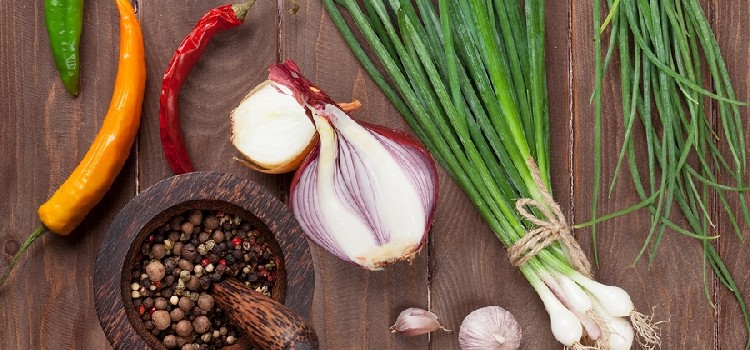Common herbs, spices, fruits, and vegetables may support your weight loss efforts and help improve your health and quality of life.
This is not something new—in fact, it’s age-old wisdom—so why all the fanfare when science “discovers” another advantage for including something as simple and common as garlic or tomato in your menu?

There are many answers, most of which have to do with our consumer-based lifestyle, a life where food is bought manufactured and pre-made for quick consumption. Foods like these have taken over in our kitchens and in our lives, all across the modern world—and this has had a serious impact on the way we live.
The science and technology behind the mainstream food industry has us…
… eating more,
… gaining harmful weight and
… getting less nutritional value out of it all.
Thankfully, researchers are also “rediscovering” some of the nutritional truths that can save us. Getting back to basics and including some of the foods that your grandparents routinely used may be just the thing to help you stop the downward spiral and get yourself back onto a path that leads to a healthy, happy life.
The Trim Down Club will launch a series of short articles—starting here—that will help to bring together what we have always known, and what we are just now finding out about some of the foods that we should have kept in our kitchen all these years. These fruits and vegetables, herbs and spices have a lot to offer our bodies and we need to get them back onto our shelves and into our diets as soon as possible.
Let’s get started!
Basil
Basil (Ocimum basilicum), also known as Saint Joseph’s Wort, is one of the most popular herbs used in cooking. A member of the mint (Lamiaceae) family, basil is native to India and other tropical areas of Asia, and is frequently featured in Indonesian, Thai, and Vietnamese cuisine.
Nutritional Value
- Rich in vitamins A, C, and K, and the minerals magnesium, iron, potassium, and calcium.
- Fresh basil is also a good source of beta-carotene, a powerful antioxidant that is converted to vitamin A in the body. Antioxdants are vital for keeping cells healthy and reducing the amount of free radical damage to the blood vessels; they also help prevent cholesterol in blood from oxidizing, a key risk factor for atherosclerosis, heart attacks, and stroke.
- Other vitamins and minerals in basil include iron, calcium, manganese, magnesium, vitamin C and potassium.
- Basil also has phytochemicals, including flavonoids and volatile oils, extracted from the leaves of the plant; among these are estragole, linalool, cineole, eugenol, sabinene, myrcene, and limonene.
Health Benefits
- Basil’s flavonoids and oils are associated with the most health benefits, the former protecting on the cellular level, and the latter yielding antibacterial properties..
- Basil extracts have been shown to reduce inflammation by inhibiting the release of pro-inflammatory cytokines (like TNF-α and IL-1) and mediators (most importantly nitric oxide). These properties have been linked to lower blood glucose, triglyceride and cholesterol levels.
- Basil oil‘s natural antimicrobial activity has been demonstrated against the growth of numerous harmful bacteria, including food-borne types such as Listeria monocytogenes, Staphylococcus spp., Escherichia (“E “) coli, Yersinia enterocolitica, and Pseudomonas aeruginosa, as well as Vibrio cholera (cholera).
Culinary Use
- Introduce basil into your meal by flavoring dishes with chopped fresh basil instead of cream-based sauces, cheese, or salt.
- Add a few leaves and a drizzle of balsamic vinaigrette to spice up greens.
- The classic tomato-basil combination is the much-beloved base for pasta sauce, Mediterranean-style pizza or tomato-mozzarella salad.
- For a Far-Eastern flair, stir a few coarsely chopped Thai basil leaves into spicy curries, soups or stir-fries until just wilted.
- Basil’s fragrant essence combines well with rosemary and thyme in protein dishes (meat, poultry, fish, tofu, tempeh, seitan), vegetables, cheese, soup, and eggs, among others.
Note: If you can’t decide between dry versus fresh, opt for the latter whenever possible—much of basil’s health benefits (not to mention flavor and aroma) come from the antioxidant compounds and essential oils that are mostly lost during the drying process. Other options are basil teas and oils, which can be found in health food stores, although the scientific evidence for its efficacy in these forms is limited.
Kale
Kale is one of the best-known “superfoods” that re-entered public appreciation in the 2010s. Its reputation is well-earned, and we’ll show you why—and how to make the most of it!
What is Kale?
Kale comes from the Brassicaceae family, which are cruciferous vegetables with dark green leaves. It is related to cabbage, chard, broccoli, cauliflower, and Brussels sprouts, among others.
Kale comes in several varieties, and most stores carry at least one while many carry at least two. A gourmet shop or farmer’s market is where you may find the best selection. If you grow your own—quite easy to do, no matter what the weather or living conditions may be—even the sky isn’t the limit!
- Curly or “Scotch” kale is probably the most unique-looking and therefore recognizable type of kale, and is sold in head-like bunches of coarse medium-green ruffled leaves.
- Ornamental kale is similar to curly kale, but more cabbage-like and “flowering” in appearance. It is most commonly available in green, white, blue, and purple hues, each color yielding its own unique health advantages through phytochemicals that support the body’s antioxidant activity.
- Lacinato or Tuscan kale (also known as “black” or “dinosaur” kale) is the next most common kale found in grocery stores. It has dark bluish green, tall, and narrow leaves with a slightly wrinkled texture. It has a slightly sweeter but earthier taste than the curly variety, with more tender leaves.
- Redbor kale is a dark almost-purple red variety, with leaves similar in texture to the curly type. It is considered to be the easiest-to-grow and most cold-tolerant of the common kales (surpassed only by Russian Red and Siberian kales and their hybrids). Despite its high nutritional value, Redbor’s beauty has made it more popular for decorating than dining, though among the “flowering” kales, it is considered to be more suited to consumption than Kamome Red kale.
- Red Russian kale is a flat, crimped, violet-veined green that resembles super-sized arugula. The leaves are slightly sweet with a dash of peppery flavor, while the stems are woody and particularly tough on the digestive system, and so generally not eaten.
- Hybrids between the above types include “Lacinato Rainbow,” combining the look of purple curly kale and tenderness and texture of Lacinato with the agricultural advantages of Redbor; “Premier” kale, which is both cold-tolerant and matures more quickly; “Winter Red” kale, a curly and more tender version of Red Russian kale; and “Red Ursa” kale, which combines Siberian and Red Russian varieties, and is one of the best types for raw consumption.
Health & Nutritional Benefits
Kale isn’t called a superfood for nothing!
- Each cup of its raw leaves, ranging from 16-85 grams depending on the type, provides up to 2 grams of fiber (within minimal available carbohydrates), 2-3 grams of protein, and all of these essential micronutrients:
Vitamins %DRI* Minerals %DRI
Vitamin A**………….. 69-442%……………….. Calcium………………… 2-14%
Vitamin B6…………….. 12-14%……………….. Copper……………….. 18-27%
Folate……………………… 5-6%……………….. Iron……………………… 2-11%
Vitamin C…………… 107-170%……………….. Magnesium…………… 2-18%
Vitamin E…………………. 2-8%……………….. Manganese…………… 6-29%
Vitamin K…………… 125-608%……………….. Potassium……………… 2-6%
*DRI = Dietary Reference Intakes, formerly Recommended Daily Allowances (RDA) **From beta-carotene
Plus important phytochemicals such as anthocyanins, carotenoids (especially lutein and zeaxanthin), chlorophyll, glucosinolates (including sulphoraphane and indole-3-carbinol), kaempferol, quercetin, and other flavonoids, phenolics, and polyphenols. - Due to its good vitamin K and calcium content, along with relatively low oxalate levels (see more about these below), kale is one of the vegetables relied upon as a plant form of calcium for bone health. Because vitamin K interferes with the activity of the blood thinner warfarin, it is important to keep a steady intake of the vitamin, to ensure the medication can be balanced accordingly.
- The fiber, electrolytes (calcium, magnesium, potassium), and vitamin C and B6 content in kale all support heart and circulatory health. Higher intake of the above minerals with lower intake of sodium is considered to be one of the most important dietary factors for balancing blood pressure.
- The combination of vitamin C with iron means the mineral can be better absorbed and utilized—on par with that from meat sources—and less likely to have undesirable effects such as generating harmful free radicals. Iron is essential for the formation of hemoglobin and enzymes, transporting oxygen to various parts of the body, cell growth, proper liver function and more.
- Isothiocyanates (ITCs) made from the glucosinolates in kale have been linked to lowered risk of several cancers, including bladder, breast, colon, ovary, and prostate. These and additional phytochemicals in kale—along with essential nutrients such as vitamins B6, C, E, and folate—have been observed in research to support the body’s natural antioxidant and other defenses against cardiovascular disease risks, as well as negative effects on muscles, skin, and hair associated with the aging process. The fiber in kale has been relied upon in traditional medicine to support normal function of the lower digestive system, likely owing to its content of fiber, water, and magnesium.
- Findings from scientific research conducted with kale have found that it increases the level of carotenoids in eye tissue that are protective against macular degeneration.
Culinary Use
- Most kale leaves and stalks tend to be a bit bitter and stiff when raw, characteristics that mellow with cooking. Younger leaves are known to be milder in flavor and softer in texture, while the sprouts are piquant and melt-in-your-mouth tender.
- Many people like to eat kale raw, either in salads or smoothies. For most it is fine in moderation, and for others, some form of cooking works best. The reason for this is that kale contains “oxalates,” which bind minerals in the body, making them unavailable. Though in some individuals high intake of oxalates can contribute to kidney stones, levels in kale are lower than in other dark leafy greens, and some evidence suggests a health-supporting role for them. Kale is also high in “goitrogens,” which can negatively impact people with hypothyroid disease, even those taking thyroid replacement medication. Cooking lessens the impact of both of these types of compounds.
- For general cooking, light steaming kale until just supple is considered best for maximizing nutritional value, with microwaving coming in second. Important beneficial but heat-sensitive kale compounds such as sulphoraphane can be protected by adding mustard seed powder to the leaves before cooking. If the leaves are boiled in liquid, it is best that the latter be consumed—i.e. as a soup or sauce—so as to not miss out on too much of kale’s nutritional value. Dehydrating, either in a dehydrator or oven, is an increasingly popular way to enjoy kale: just toss with a little olive oil and seasoning, and you’re on your way to a flavorful and flavorful alternative to unhealthy snacks.
Whether you are new to kale or a long-time fan looking to expand your repertoire, here are a few of our most popular recipes:




I lost 16 pounds so far, I’m loving this app. I’m gonna keep going. I’ll up date my progress in 2 weeks. Thanks Trim Down
Joined the trim down club in January, never even looked through the site. Just been paying every month. Guess I’ll put my money to good use! lol
I just started the trim down club. Im on day 3. I love that there is someone to reach out to if you have questions, and love that there is options to choose from if you don’t like or want a food item. And feeling very full and satified, alot of food!!
Hi, bwiedder53. That’s wonderful to read! We are indeed happy to help however we can.
HI, I am new also. Love everything I have read so far. Some things are hard for me to find in my small community but not impossible ( I hope). My goal is to lose weight but to become healthier in the process. This fits the bill. Thanks
Nancy
I have just started the club and am glad you people are so focused and honest
Hi,
I have just joined the club and I’m really excited and at the same time nervous.
I just joined, and have just begun on my journey to a new me! I am pumped as I have already noticed a slight change in my clothes…..trimdownclub works because it fits my schedule…I’ll keep you posted as I achieve my goals! Broke it into levels……how exciting is this!
Just starting,after many failed diets .lost my husband eight weeks ago and looking to re invent myself.Need something new to focus on.
Hi
I’m over the moon with this healthy eating plan, I am nearly at the end of my 3rd week and have lost 10 pounds yippee!!! A dance round the kitchen will not go amiss – thanks very much
Lesley – Isle of Wight, England
We’re over the moon for you, too, Lesley! We wish you continued health, and are happy to help in whatever way we can 🙂
Hi can you please tell me how long can you keep banana bread for ??
Hi, Rusty. In the refrigerator it can usually last for several days to about a week; in the freezer, it can last indefinitely.
Beginning my 3rd week, have lost 7 lbs!! I’m afraid I’ll tire of the diet but so far, so good!!!
Congratulations, stea7002! Hope is still going well, and we’re here to help if you need it 🙂
I sure I found a page that told what you can eat freely like bean sprouts and fruit. Can anyone help me to get this page. Thanks Pat
In the Personal Menu Planner application (in “Apps” above), you will see a category of “Free Foods.”
I am finding it hard to fit in the 6 meals a day, but I have list a little weight. Will keep going as I am enjoying the variety.
Hope to get my head round this plan and see the benefits!
I am into my 4th week on my Trim Down menu and although I have not lost hardly any weight I can see and feel a difference in my clothes. It does seem strange that the more you eat the better you feel, but eating a healthy diet really does work.
I just got started and I am also finding it hard to fit in 6 meals a day. I try to follow the menu, but some things I don’t like and do a substitution. I’ve lost a little weight and feel good about it.
Hi, G.S. Young and welcome! Do what’s comfortable for you – it looks like you’re on the right track.
1 week in and I have lost weight, this is a good sign.
I am finding that I am less hungry by eating more often!!!!! Go figure
It was strange at first getting used to the mix of foods. I,m still finding it difficult to fit in 6 meals a day but must admit I am feeling some health benefit and slowly losing a little weight. I’m determined to continue and will update my recors shortly